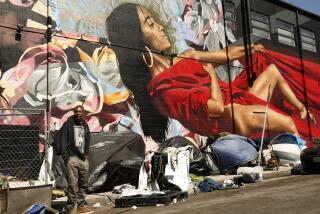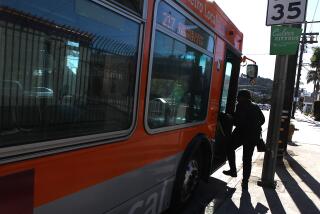MTA seeks sales tax hike
The Metropolitan Transportation Authority board on Thursday voted overwhelmingly to seek a half-cent-on-the-dollar sales tax increase that could raise $30 billion to $40 billion for transit and highway projects, including the first link of a long-awaited subway to the sea.
The 13-member board’s action, approving a ballot measure for the Nov. 4 election, is a major step that could lead to construction of several dozen transportation projects in the county over the next three decades.
Before the measure can be placed on the ballot, the Legislature must authorize it, which Los Angeles Mayor Antonio Villaraigosa says he is confident will happen soon. A bill, AB 2321, by Assemblyman Mike Feuer (D-Los Angeles) is pending in the Senate.
“This is a historic moment,” Feuer told the MTA board before the vote. “We know our residents are calling on us to seize this moment. This is an opportunity that won’t come again, not for a generation.”
If approved by a required two-thirds majority, Measure R -- for relief, as in traffic relief -- would boost Los Angeles County’s sales tax rate to 8.75%, tying it with Alameda County’s for the highest in California.
Currently, one cent of the county’s existing sales tax of 8.25 cents on the dollar goes for transportation projects in perpetuity. Voters approved a half-cent transportation tax in 1980 and another in 1990. The money has helped pay for bus purchases, construction of the Red Line subway and some light rail lines.
The Los Angeles County Economic Development Corp. estimates that the new tax would cost each county resident an average of about $25 a year. The half-cent increase would, for example, translate into an extra $125 in sales taxes on the purchase of a $25,000 car for residents of the county.
MTA officials say the measure could raise $30 billion to $40 billion over its 30-year life span, depending on the state of the economy and consumer spending habits. About 65% of the revenue would be used to expand the county’s bus and rail systems, while 35% would be earmarked for highways, streets and, potentially, bikeways and sidewalks.
The county’s rail system comprises Metrolink, the Red and Purple lines subway system and the Blue, Green and Gold light rail lines. The MTA also operates one of the largest public-transit bus systems in the nation.
Thirteen mass transit projects and 16 road projects would split the money raised by the tax increase. There would also be about $6 billion to be shared by all the cities in the county for their own projects.
“This has the potential to provide funding for much needed transportation projects,” said Douglas Failing, director of California Department of Transportation operations in Los Angeles and Ventura counties. “It is a good mix of transit and road projects.”
Various elected officials, particularly those representing the San Gabriel Valley, have complained, however, that their regions might not get their fair share of projects from the sales tax increase, and they want assurances that a Gold Line extension from Pasadena to Claremont would be funded immediately.
In particular, they want the board to give the Gold Line $80 million now so they can begin seeking more than $300 million in federal money. The board declined to do so Thursday.
“We’ve never been a priority for the MTA,” said Habib Balian, chief executive of the Gold Line Foothill Extension Construction Authority.
Villaraigosa said that Gold Line proponents shouldn’t worry and that the extension would be one of the first lines built, along with the Expo Line, which will run from downtown to USC to Culver City.
The mayor was ebullient after the 9-2 vote in favor of the measure.
“I worked very hard for those nine votes,” he said. “I think it’s indicative of the desperation that those who use our public transportation systems and highways feel.”
To head off potential opposition, Villaraigosa persuaded board members to use sales tax money to push back to 2010 an MTA fare increase scheduled for 2009. The deal would also freeze fares for seniors, students, the disabled and Medicare users for five years.
Nevertheless, officials of the Bus Riders Union, an advocacy group, vowed to oppose the sales tax increase because they said it would funnel too much money to rail and not enough to buses, the backbone of the county’s transit system.
County Supervisor and MTA board member Gloria Molina said she could not support the sales tax because she believed the list of projects was thrown together quickly and was not fair to some parts of the county.
“I think we are hurting ourselves in the long run,” said Molina, who also complained that the Westside was getting a subway whereas the Eastside got a light rail line.
On the final vote, she abstained, and Supervisor Mike Antonovich and Duarte City Councilman John Fasana voted “no.”
For more than two decades, the Los Angeles area has consistently ranked No. 1 in the country for the most time-consuming commutes. Today, studies show that the average motorist in the region is delayed 72 hours a year by traffic congestion -- about double what it was 25 years ago.
If nothing is done, regional planners predict, the delay could grow by up to 80% in Los Angeles County by 2030, when the population, now 10 million, is expected to hit 12 million.
Rising construction costs and a failure to raise state and federal fuel taxes since the mid-1990s have reduced the ability of state and local government to keep pace with the transportation demands of a growing population.
The situation has become particularly acute since 2001. During the last seven years, Govs. Gray Davis and Arnold Schwarzenegger, along with state legislators, have repeatedly diverted transportation money to help balance deficit-plagued budgets. About $5.8 billion channeled for other uses has yet to be repaid, according to the California Transportation Commission.
Transportation “should be funded by the state and federal government -- they have fallen down on the job,” said Kenneth Alpern, president of the Transit Coalition, a local mass transit advocacy group. “Despite the morality of who should pay for it, L.A. County must rely on itself and the best thing is it allows us to have control over where money is spent.”
Others said the spending plan for the sales tax revenue was ill-advised and would not help relieve traffic problems.
Ryan Snyder, a transportation planner in Los Angeles, said far more money should be spent on the bus system, which, in a sprawling city, has the flexibility to move a lot more people than fixed rail lines.
Brian D. Taylor, a transportation expert at UCLA, said the proposed sales tax increase raises equity questions because the burden would fall disproportionately on the poor and low-wage earners.
“By almost any measure of efficiency and equity, sales taxes do poorly compared to other options, such as tolling, raising fuel taxes or floating bonds,” Taylor said. “But sales taxes have been proven politically around California and the nation as the most effective way to raise money. Voters always go along with them.”
“There’s no end to their gall when it comes to reaching for taxpayers’ wallets,” said Kris Vosburgh, executive director of the Howard Jarvis Taxpayers Assn. He objected to any increase in the sales tax. “We are already the second highest in the state when it comes to county sales taxes. . . . The problem here is that it is terribly regressive and it hits the poor people much harder than the wealthy.”
The MTA proposal is similar to measures that have been adopted in the last 25 years by surrounding counties. Those counties include Orange, Riverside and San Bernardino, which sought the tax revenue to offset declines in state transportation funding.
Orange County’s Measure M, which also required a two-thirds majority, was placed on the ballot several times in the late 1980s and early ‘90s before voters approved it. The tax was renewed by voters last year and is expected to generate $12 billion from 2011 through 2041.
--
steve.hymon@latimes.com
--
(BEGIN TEXT OF INOFBOX)
Tax comparisons
The half-cent sales tax increase would boost Los Angeles County’s total to 8.75%, tying Alameda County for the highest sales tax rate in California.
Existing county rates
Los Angeles: 8.25%
Orange: 7.75%
Riverside: 7.75%
San Bernardino: 7.75%
Ventura: 7.25%
Source: California State Board of Equalization
More to Read
Start your day right
Sign up for Essential California for news, features and recommendations from the L.A. Times and beyond in your inbox six days a week.
You may occasionally receive promotional content from the Los Angeles Times.







